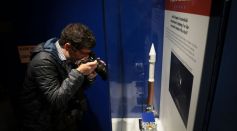SPACE
Star-Birthing Galaxies Could Hide Supermassive Black Holes With Quasar-Blocking Dust [Study]
War in Space: Israel’s Arrow Missile Defense System Intercepts Alleged Aerial Threat From Iran-Backed Rebels Outside Earth’s Atmosphere

NASA's James Webb Space Telescope, Chandra X-Ray Observatory Find Most Distant Black Hole Ever Seen

Auroras in Texas? Rare Solar Eruptions Paint Southern US Skies with Vibrant Northern Lights

Chunks of Alien Planet 'Theia' Could Be Hidden Near Earth's Core, Study Suggests

Celestial Highlights This Week: Watch Out For the Venus-Moon Conjunction, Meteor Shower, and More
First Radio Telescope Images Capture the 'Ring of Fire' Effect in Annular Solar Eclipse, Defying Expectations
Martian Meteorites Striking Earth Found To Be Younger Than Expected: Unearthing Insights Into the Red Planet's Geological History

Asteroid Bennu: Samples of the Potentially Hazardous Asteroid Now Available For Viewing in 1st Public Display in Smithsonian Museum

Sierra Space’s First Dream Chaser Vehicle Completed: Know More About the Novel Spacecraft That Could Redefine Space Travel
SpaceX Pushes Back Robotic Mission for Next Dragon Cargo Launch

Lost in Space? Here’s How You Can Find Your Way Back to Earth

How Old Is Our Sun? How Long Will It Shine?
Mysterious 'Blobs' in Earth's Mantle Might Be the Remnants From the Protoplanet Collision That Birthed the Moon
Most Popular

Largest Known Volcanic Aquifer Discovered Beneath Oregon's Cascades

New 'Supergiant' Sea Bug Found in South China Sea, Named After Darth Vader

Mediterranean Sea Was Refilled by a Catastrophic Flood Millions of Years Ago

Mysterious Cosmic Waves That Sound Like Birds Detected in Unexpected Space Region




